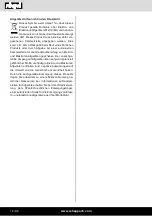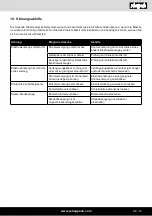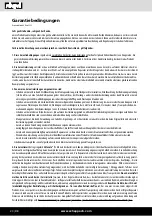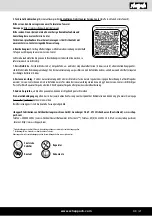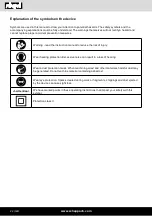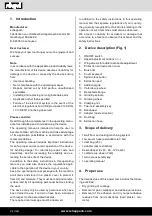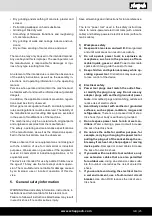
www.scheppach.com
32 |
GB
14. Electrical connection
The electrical motor installed is connected and ready
for operation. The connection complies with the appli-
cable VDE and DIN provisions.
The customer‘s mains connection as well as the ex-
tension cable used must also comply with these reg
-
ulations.
Damaged electrical connection cable
The insulation on electrical connection cables is often
damaged.
This may have the following causes:
• Pressure points, where connection cables are
passed through windows or doors.
•
Kinks where the connection cable has been improp
-
erly fastened or routed.
• Places where the connection cables have been cut
due to being driven over.
•
Insulation damage due to being ripped out of the wall
outlet.
•
Cracks due to the insulation ageing.
Such damaged electrical connection cables must not
be used and are life-threatening due to the insulation
damage.
Check the electrical connection cables for damage
regularly.
Ensure that the connection cables are dis-
connected from electrical power when checking for
damage.
Electrical connection cables must comply with the ap
-
plicable VDE and DIN provisions.
Only use connection
cables of the same designation.
The printing of the type designation on the connection
cable is mandatory.
For single-phase AC motors, we recommend a fuse
rating of C 16A or K 16A for machines with a high start
-
ing current (from 3000 watts)!
•
For in-house extraction:
Let the electric tool run
for a few more seconds to remove any remaining
dust from the suction hose (19).
12.2 Grinding close to the edge (Fig. 5, 6)
A cover segment (6) of the protection and extraction
bonnet (4) can be removed for grinding close to the
edge.
This allows the insert tool to reach closer to floor,
wall and ceiling edges as well as existing installations
such as pipes.
The adjacent surfaces can thus be pre
-
cisely machined.
Expect dust to be generated during this work, as the
protective and extraction cover (4) is no longer closed.
•
Pull the cover segment (6) forwards out of the pro
-
tection and extraction cover (4).
•
Machine the areas near the edges.
•
Put the cover segment (6) back on the extraction
cover (4) until it clicks into place.
13.
Operation
Direction of rotation of the tool!
13.1 Switching on
To switch on the device, slide the on/off switch (1) for
-
ward.
To lock the on/off switch (1), press the on/off switch (1)
down at the front until it clicks into place.
13.2 Switching off
To switch off the electric tool, release the on/off switch
(1).
If it is locked, press the on/off switch (1) in the rear area
briefly and then release it.
13.3 Adjusting the speed
Before starting work, set the speed to suit the appli
-
cation.
Use a low speed for coarse grinding work, in
-
crease the speed for fine work.
•
Adjust the speed by pressing the buttons (2).
•
Press the + button (2) to increase the speed.
•
Press the – button (2) to decrease the speed.
NOTE:
The insert tool rotates after it has been switched
off.
Wait until the insert tool has come to a standstill be
-
fore putting the device down.
Summary of Contents for 5903818901
Page 2: ...www scheppach com 2 1 5 2 1 6 9 3 4 8 7 ...
Page 3: ...www scheppach com 3 10 3 2 11 12 13 14 15 16 10 19 15 17 18 ...
Page 4: ...www scheppach com 4 3 2 4 5 6 14 12 13 10 11 15 ...
Page 105: ...www scheppach com SI 105 ...
Page 117: ...www scheppach com 117 ...
Page 118: ...www scheppach com 118 ...

